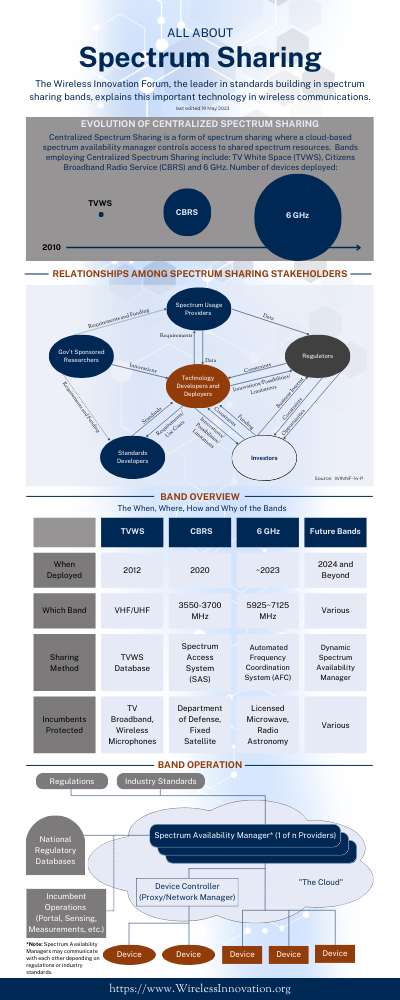- Home
- Knowledge Center
- Reports, Recommendations and Specifications
- Information Documents
- All About Spectrum Sharing Infographic
- Free Webinars
- Tech Talks
- Setting the Standard Video Blog
- Beyond the Radio Dial Video Blog
- Conference Proceedings
- Workshop Proceedings
- Springer Journals
- Market Studies
- What is the SCA?
- Issue Submissions
- Reference Implementations
- What is SDR?
- What are CR and DSA?
- About Us
- Events
- News
- Projects & Committees
- Members
- Join the Forum
The following lists of abbreviations and definitions are accumulated from the FCC rules, the SSC requirements, and the SSC protocol definitions. This page will be updated as required to represent the most recent definitions.Abbreviations3GPP 3rd Generation Partnership Project CA Certificate Authority CBRS Citizens Broadband Radio Service. CBSD Citizens Broadband radio Service Device CBSD-ID CBSD Identifier CFR Code of Federal Regulation CGI CBSD Group Identifier CPI Certified Professional Installer CPIDI Certified Professional Installer Device Information CPIR-ID Certified Professional Installer Registration Identification DoD U.S. Department of Defense DP Domain Proxy EIRP Effective Isotropic Radiated Power ESC Environmental Sensing Capability EUD End User Device FCC Federal Communications Commission FFS For Further Study FRN FCC Registration Number FSS Fixed-Satellite Service GAA General Authorized Access HAAT [antenna] Height Above Average Terrain HTTP Hypertext Transfer Protocol HTTPS HTTP over TLS. ID Identifier, Identity JSIR Joint Spectrum Interference Resolution JSON Javascript Object Notation MFCN Mobile / Fixed Communication Networks NTIA National Telecommunications and Information Administration OA&M Operations, Administration and Maintenance OpenSSRF Open source Standard Spectrum Resource Format PA Priority Access PAL Priority Access License PAL-ID Priority Access License Identifier PPA PAL Protection Area PPA-ID PAL Protection Area Identifer SAS Spectrum Access System SMLA Secondary Market Leasing Agreement TLS Transport Layer Security UR-ID User Registration Identifier URL Universal Resource Locator UTC Coordinated Universal Time WBS Wireless Broadband Service (FCC Rules Part 90, Subpart Z) WISP Wireless Internet Service Provider (operated under WBS) DefinitionsBlacklist: A list of CBSDs that are to be denied service. [Source: WINNF-16-S-0016 SAS to CBSD Technical Specification V1.0.1] Category A CBSD. A lower power CBSD that meets the general requirements applicable to all CBSDs and the specific requirements for Category A CBSDs set forth in sections 96.41 and 96.43. [Source: FCC rules] Category B CBSD. A higher power CBSD that meets the general requirements applicable to all CBSDs and the specific requirements for Category B CBSDs set forth in sections 96.41 and 96.45. [Source: FCC rules] CBRS: Citizens Broadband Radio Service. CBRS band: The 3550-3700 MHz Citizens Broadband Radio Service band. [Source: WINNF-16-S-0016 SAS to CBSD Technical Specification V1.0.1] CBSD Antenna: The radiating element(s) of the CBSD. Each CBSD has one CBSD Antenna. Note that the CBSD’s antenna may be instantiated with multiple physical antennas (e.g., an antenna array for MIMO operation), but those antennas must be transmitting one aggregate waveform collectively from a single geolocation, and with a total transmit power that conforms to all the CBSD’s registration parameters and authorized transmit power levels provided by the SAS in its active Grants (e.g., maximum allowable EIRP).. [Source: WINNF-16-S-0016 SAS to CBSD Technical Specification V1.0.1] CBSD-ID: The system-wide unique identifier for registered CBSDs. [Source: WINNF-15-S-0112-V2.0.0 CBRS Operational and Functional Requirements] CBSD Group Identifier (CGI): An identifier used to allow one or more registering CBSDs to identify as a group that the CBSD User for those CBSDs has established. [Source: WINNF-15-S-0112-V2.0.0 CBRS Operational and Functional Requirements] CBSD Registration: The procedure by which a CBSD indicates to a SAS its intention to operate. Successful registration implies a validation by the SAS that the CBSD has been FCC certified and confers on the CBSD the right to be authorized by the SAS to operate in accordance with a Grant. During the registration process, each CBSD provides a fixed location, unique identifiers (e.g., owner information, device information), Group membership, and radio-related capabilities. A successful registration procedure concludes with the SAS providing a unique identifier for that CBSD. [Source: WINNF-16-S-0016 SAS to CBSD Technical Specification V1.0.1] CBSD User: The registered entity that has operational responsibility for the CBSD. [Source: WINNF-15-S-0112-V2.0.0 CBRS Operational and Functional Requirements] Census Tract. Statistical subdivisions of a county or equivalent entity that are updated prior to each decennial census as part of the Census Bureau's Participant Statistical Areas Program. Census tracts are defined by the United States Census Bureau and census tract maps can be found at http://www.census.gov. For purposes of this part, Census Tracts shall be defined as they were in the 2010 United States Census. The Commission may from time to time update this definition to reflect boundaries used in subsequent decennial Census definitions. [Source: FCC rules] Certified Professional Installer (CPI): Any individual trained and currently validly certified from an accredited CPI Training Program based on the relevant Part 96 rules and associated technical best practices for the Citizens Broadband Radio Spectrum (CBRS). [Source: WINNF-15-S-0112-V2.0.0 CBRS Operational and Functional Requirements] Channel: The contiguous frequency range between lower and upper frequency limits. [Source: WINNF-16-S-0016 SAS to CBSD Technical Specification V1.0.1] Citizens Broadband Radio Service Device (CBSD): Fixed Stations, or networks of such stations, that operate on a Priority Access or General Authorized Access basis in the Citizens Broadband Radio Service consistent with this rule part [Title 47 CFR Part 96]. For CBSDs which comprise multiple nodes or networks of nodes, CBSD requirements apply to each node even if network management and communication with the SAS is accomplished via a single network interface. [Source: FCC rules] Cluster List: The set of CBSDS, identified by their CBSD-IDs, that define a PPA. The PAL Holder provides this Cluster List to the Managing SAS. These are the CBSDs that provide service and coverage within the claimed PPA. [Source: WINNF-15-S-0112-V2.0.0 CBRS Operational and Functional Requirements] CPI Accreditation Standard: Standard defining how a CPI Training Program Administrator can be accredited to run a Certified Professional Installer (CPI) Training Program. The CPI Accreditation Standard includes a curriculum standard defining the requirements necessary for trainees to be certified as a Certified Professional Installer. The CPI Accreditation Standard includes a requirement for an objective certification test to be administered by a program administrator as part of the CPI Training Program. Passing this test is a prerequisite for an individual to be considered a Certified Professional Installer. [Source: WINNF-15-S-0112-V2.0.0 CBRS Operational and Functional Requirements] CPI Accrediting Body: Entity that accredits a CPI Training Program Administrator to offer a CPI Training Program based on the CPI Accreditation Standard. This entity must be independent from CPI Training Program Administrators. [Source: WINNF-15-S-0112-V2.0.0 CBRS Operational and Functional Requirements] Certified Professional Installer Device Information (CPIDI): The body of information required to be entered by a CPI to register a valid CBSD with a SAS for installation and to allow for spectrum grant requests and transmission pursuant to Part 96 rules, industry standards, or SAS specific requests. [Source: WINNF-15-S-0112-V2.0.0 CBRS Operational and Functional Requirements] Certified Professional Installer Registration Identification (or ID) (CPIR-ID): The unique identifier provided by the CPI Accrediting Body through the CPI Training Program to CPIs who are validly and currently certified and registered as CPIs. [Source: WINNF-15-S-0112-V2.0.0 CBRS Operational and Functional Requirements] Certified Professional Installer Training Program: A required training curriculum contained in a valid program, as defined by the CPI Accrediting body, for certification of a CPI. Such curriculum may have mandatory (such as Part 96 and rules based requirements) and optional components (such as industry best practices or manufacturer or SAS specific training). [Source: WINNF-15-S-0112-V2.0.0 CBRS Operational and Functional Requirements] CPI Training Program Administrator: Entity such as a network equipment operator, an equipment vendor, a SAS administrator or a 3rd party training organization that develops a Certified Professional Installer (CPI) Training Program, gains accreditation, administers the objective certification test and maintains certification records.[Source: WINNF-15-S-0112-V2.0.0 CBRS Operational and Functional Requirements] Cluster List: The set of CBSDs, identified by their CBSD-IDs, that define a PPA. The PAL Holder provides this Cluster List to the Managing SAS. These are the CBSDs that provide service and coverage within the claimed PPA. [Source: WINNF-15-S-0112-V2.0.0 CBRS Operational and Functional Requirements] Coastline. The mean low water line along the coast of the United States drawn according to the principles, as recognized by the United States, of the Convention on the Territorial Sea and the Contiguous Zone, 15 U.S.T. 1606, and the 1982 United Nations Convention on the Law of the Sea, 21 I.L.M. 1261. [Source: FCC rules] Domain Proxy: An entity engaging in communications with the SAS on behalf of multiple individual CBSDs or networks of CBSDs. The Domain Proxy can also provide a translational capability to interface legacy radio equipment in the 3650-3700 MHz band with a SAS to ensure compliance with Part 96 rules. [Source: WINNF-15-S-0112-V2.0.0 CBRS Operational and Functional Requirements] [Duplicated in WINNF-16-S-0016 SAS to CBSD Technical Specification V1.0.1] End User Device. A device authorized and controlled by an authorized CBSD. These devices may not be used as intermediate service links or to provide service over the frequencies listed in section 96.11 to other End User Devices or CBSDs. [Source: FCC rules] Environmental Sensing Capability (ESC). A system that detects and communicates the presence of a signal from an Incumbent User to an SAS to facilitate shared spectrum access consistent with sections 96.15 and 96.67. [Source: FCC rules] Exclusion Zone. A geographic area wherein no CBSD shall operate. Exclusion Zones shall be enforced and maintained by the SAS. Exclusion Zones will be converted to Protection Zones following the approval and commercial deployment of an ESC and SAS consistent with this part. [Source: FCC rules] Fixed Station. A CBSD or End User Device that transmits and/or receives radio communication signals at a fixed location. Fixed Stations may be moved from time to time but Fixed CBSDs must turn off and re-register with the SAS prior to transmitting from a new location. [Source: FCC rules] General Authorized Access (GAA) User. An authorized user of one or more CBSDs operating on a General Authorized Access basis, consistent with section 96.33, et seq. [Source: FCC rules] Geo-Location Capability. The capability of a CBSD to register its geographic coordinates within the level of accuracy specified in section 96.39. The CBSD location is used by the SAS to determine frequency availability and maximum transmit power limits for CBSDs. [Source: FCC rules] Grandfathered Wireless Broadband Licensee. A licensee authorized to operate in the 3650-3700 MHz band consistent with section 90.1338. [Source: FCC rules] Grandfathered Wireless Protection Zone. A geographic area and frequency range in which Grandfathered Wireless Broadband Licensees will receive protection from Citizens Broadband Radio Service transmissions and defined using methodology determined by the Wireless Telecommunications Bureau and Office of Engineering and Technology. [Source: FCC rules] Grant: The authorization provided by a SAS to a CBSD, subject to a Heartbeat exchange, to transmit using specified operating parameters. Grants are identified by a unique Grant identifier. Once issued, a Grant’s operating parameters are never changed; if new or modified operating parameters are required, then a new Grant must be obtained. The Grant's operating parameters are maximum EIRP and Channel. A Grant can be in different states as defined in section 7. [Source: WINNF-16-S-0016 SAS to CBSD Technical Specification V1.0.1] Group: A collection of CBSDs which are provided a special, common form of management by the SAS. The nature of the special management is dependent on Group type. [Source: WINNF-16-S-0016 SAS to CBSD Technical Specification V1.0.1] Incumbent User. A federal entity authorized to operate on a primary basis in accordance with the table of frequency allocations, fixed satellite service operator, or Grandfathered Wireless Broadband Licensee authorized to operate on a primary basis on frequencies designated in section 96.11. [Source: FCC rules] License Area. The geographic component of a PAL. Each License Area consists of one Census Tract. [Source: FCC rules] Managing SAS: The SAS that administers a PAL and serves the CBSDs that form the Cluster List of a PPA registered to a PAL Holder that is authorized to use that PAL. This Managing SAS is the SAS which accepts, checks, and validates a PPA claim and which issues a PPA-ID for a valid PPA, and which shares the PPA-ID and the PPA vertex points with all SASs. Subsequently, the Managing SAS serves the CBSDs on the PPA Cluster List. The Managing SAS also serves CBSDs using GAA grants and their CBSD Users. [Source: WINNF-15-S-0112-V2.0.0 CBRS Operational and Functional Requirements] Maximum Allowable PPA Contour Method: The FCC mandated contour calculation method that defines the maximum allowable size of a PPA. This is based upon the modeled calculated coverage of the CBSDs on the PPA’s Cluster List, the CBSDs’ maximum allowable EIRPs, the CBSDs’ antenna heights and antenna parameters, the RF propagation model, and a 96 dBm/10 MHz coverage threshold. [Source: WINNF-15-S-0112-V2.0.0 CBRS Operational and Functional Requirements] Mobile Station. A device intended to be used while in motion or during halts at unspecified points. [Source: FCC rules] Non-Public Registration Data: CBSD registration data that would allow one to identify a licensee and must [shall] therefore be obfuscated pursuant to FCC Requirement 96.55(a)(3). [Source: WINNF-15-S-0112-V2.0.0 CBRS Operational and Functional Requirements] PAL-ID: The system-wide unique identifier for a PAL. [Source: WINNF-15-S-0112-V2.0.0 CBRS Operational and Functional Requirements] PAL Database: The system-wide accessible database that allows the look-up of a PAL boundary and PAL ownership based upon the PAL-ID. [Source: WINNF-15-S-0112-V2.0.0 CBRS Operational and Functional Requirements] PAL Holder: The registered entity who has legal rights to make PPA claims under the registered PAL. [Source: WINNF-15-S-0112-V2.0.0 CBRS Operational and Functional Requirements] PAL-ID: The system-wide unique identifier for a PAL. [Source: WINNF-15-S-0112-V2.0.0 CBRS Operational and Functional Requirements] PAL Reserved Channel: A 10 MHz channel in the range of 3550-3650 that a SAS may establish for exclusive use of a set of one or more CBSDs that are registered as belonging to a PPA based upon acquired PAL rights. [Source: WINNF-16-S-0016 SAS to CBSD Technical Specification V1.0.1] Portable Station. A device designed to be used within 20 centimeters of the body of the user. [Source: FCC rules] PPA: PAL Protection Area. An area within a PAL established by a PAL owner for protecting exclusive use of channels based upon the acquisition of PAL rights. The area is based upon the coverage area of the set of CBSDs that are members of the PPA. The SAS maintains a list of CBSDs that are members of the PPA. [Source: WINNF-16-S-0016 SAS to CBSD Technical Specification V1.0.1] PPA-ID: The system-wide unique identifier for a PPA. [Source: WINNF-15-S-0112-V2.0.0 CBRS Operational and Functional Requirements] PPA Database: The system-wide accessible database that allows the look-up of a PPA boundary and associated PAL information based upon the PPA-ID. [Source: WINNF-15-S-0112-V2.0.0 CBRS Operational and Functional Requirements] Priority Access License (PAL). A license to operate on a Priority Access basis, consistent with section 96.23, et seq. [Source: FCC rules] Priority Access Licensee. A holder of one or more PALs. Priority Access Licensees shall be entitled to protection from General Authorized Access Users and other Priority Access Licensees within the defined temporal, geographic, and frequency limits of their PAL, consistent with the rules set forth in this part. [Source: FCC rules] Protection Zone. A geographic area wherein CBSDs may operate only with the permission of an approved SAS and ESC. [Source: FCC rules] Public Registration Data: Data that SAS Administrators must share with the public according to FCC requirement 96.55(a)(3). [Source: WINNF-15-S-0112-V2.0.0 CBRS Operational and Functional Requirements] Rural Area. For purposes of this Part, any Census Tract which is not located within, or overlapping: (i) a city, town, or incorporated area that has a population of greater than 20,000 inhabitants; or (ii) an urbanized area contiguous and adjacent to a city or town that has a population of greater than 50,000 inhabitants. [Source: FCC rules] SAS Essential Data: SAS-Essential Data are defined as data shared between any two SASs which are required to fulfill all SAS functions required by 47 C.F.R Part 96. [Source: WINNF-15-S-0112-V2.0.0 CBRS Operational and Functional Requirements] Service Area. One or more contiguous License Areas held by the same Priority Access Licensee. [Source: FCC rules] SMLA: Secondary Market Leasing Agreement. The leasing terms by which PAL rights are conveyed from a PAL licensee to an eligible lessee. [Source: WINNF-15-S-0112-V2.0.0 CBRS Operational and Functional Requirements] Spectrum Access System (SAS). A system that authorizes and manages use of spectrum for the Citizens Broadband Radio Service in accordance with Title 47 CFR Part 96 subpart F. [Source: FCC rules] SAS Administrator. An entity authorized by the Commission to operate an SAS in accordance with the rules and procedures set forth in section 96.63. [Source: FCC rules] Spectrum Access System (SAS): A system that authorizes and manages use of spectrum for the Citizens Broadband Radio Service in accordance with subpart F in Electronic Code of Federal Regulations, Title 47, Chapter I, Subchapter D, Part 96. [Source: WINNF-16-S-0016 SAS to CBSD Technical Specification V1.0.1] UR-ID: User Registration ID. The system-wide unique identifier for Registered Users of the CBRS; these may be CBSD Users or PAL Holders. [Source: WINNF-15-S-0112-V2.0.0 CBRS Operational and Functional Requirements] |



